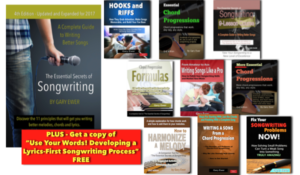There’s so much about songwriting that seems random. You could choose practically any chord progression, any melodic shape, any hook, any combination of words for the lyric. So when you look at it that way, it seems that randomness is a key feature of songs.
 The success of a pop song often comes down to the success of the hook. If you’re stuck at the hook-stage of writing, you need to read “Hooks and Riffs: How They Grab Attention, Make Songs Memorable, and Build Your Fan Base”. It’s part of “The Essential Secrets of Songwriting 10-eBook Bundle”
The success of a pop song often comes down to the success of the hook. If you’re stuck at the hook-stage of writing, you need to read “Hooks and Riffs: How They Grab Attention, Make Songs Memorable, and Build Your Fan Base”. It’s part of “The Essential Secrets of Songwriting 10-eBook Bundle”
But that’s only the way audiences should see it. In fact, if the whole process were truly random, I don’t think we’d be able to talk about good songwriters and bad songwriters. Randomness should dictate that each time you write a song, it might be a good one, and it might not be.
But we know that there are songwriters who just seem to get things right most of the time. So how do you get beyond randomness and increase the odds that you’ll write a good song?
Let’s take melodies as an example. What do you do to make sure that you’re song melody works?
A good melody relies on a good structure. That means that despite the fact audiences might hear a melody as a somewhat random collection of notes, you, as a songwriter, should know the following:
- Melodies usually support the chords, and chords support the melody. A chord progression should target the tonic chord (the chord representing the key of your song), but so too should melodies.
- In verse-chorus songs, melodies usually rise through the verse, sit higher in the chorus, and descend just before the end of the chorus.
- In verse-only songs, melodies usually rise for the first part, find a high point somewhere near the end, and then finish lower at the end of that verse.
- Melodies should use quicker rhythms in the verse, and longer, simpler rhythms in the chorus, particularly the part of the chorus that includes the title lyric.
- Melodies should use mainly stepwise motion, moving from one note to the next one up or down. Occasional leaps help bring out the emotional content of certain words in the lyric.
There’s a lot more that could be said about melodies, and certainly not every song will exhibit every one of those characteristics.
But noting just those 5 characteristics is enough to tell us that even though melodies might seem random, there is a strong sense of structure that supports every melody.
And for every one of those characteristics, you could write a chapter that would describe how they work to make melodies strong, enjoyable, singable, and memorable.
The Power of a Line Drawing
If you want to start putting more attention on how your song melodies work, try doing the following: make a line drawing of your melody. As the melody rises, your pencil line should rise; as it descends, your line should move down.
We know from looking at thousands of songs from the past 6 or 7 decades of pop music that most song melodies will exhibit some kind of inverted-V or inverted-U shape. That is, they’ll start low, work their way higher, and then finish by moving lower. The line will be jagged, but you’ll notice the vague upward and downward movement of the line.
Sometimes that inverted U or V will look lopsided; that’s OK, and in fact, that’s normal. Melodies typically take more time rising than they do falling.
But if, after you’ve created your line drawing, you’re seeing a line that looks completely random, then you’ve got some work to do. Go back and rewrite your melody so that you start lower, move higher, and then finish lower.
The best way to start this exercise is to take a song you know well, like a Beatles tune, let’s say, and make a line drawing. “Hey Jude” will give you this inverted-V shape.
There are lots of ways to strengthen the structure of a melody, but ensuring that it follows that inverted U shape is one good way to be sure that you’ve got something that has a hope of working well.
 Written by Gary Ewer. Follow Gary on Twitter.
Written by Gary Ewer. Follow Gary on Twitter.
 “The Essential Secrets of Songwriting” eBook bundle includes“Writing a Song From a Chord Progression”. Discover the secrets of making the chords-first songwriting process work for you.
“The Essential Secrets of Songwriting” eBook bundle includes“Writing a Song From a Chord Progression”. Discover the secrets of making the chords-first songwriting process work for you.










